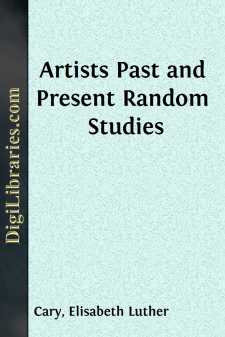Categories
- Antiques & Collectibles 13
- Architecture 36
- Art 48
- Bibles 22
- Biography & Autobiography 813
- Body, Mind & Spirit 142
- Business & Economics 28
- Children's Books 17
- Children's Fiction 14
- Computers 4
- Cooking 94
- Crafts & Hobbies 4
- Drama 346
- Education 46
- Family & Relationships 57
- Fiction 11829
- Games 19
- Gardening 17
- Health & Fitness 34
- History 1377
- House & Home 1
- Humor 147
- Juvenile Fiction 1873
- Juvenile Nonfiction 202
- Language Arts & Disciplines 88
- Law 16
- Literary Collections 686
- Literary Criticism 179
- Mathematics 13
- Medical 41
- Music 40
- Nature 179
- Non-Classifiable 1768
- Performing Arts 7
- Periodicals 1453
- Philosophy 64
- Photography 2
- Poetry 896
- Political Science 203
- Psychology 42
- Reference 154
- Religion 513
- Science 126
- Self-Help 84
- Social Science 81
- Sports & Recreation 34
- Study Aids 3
- Technology & Engineering 59
- Transportation 23
- Travel 463
- True Crime 29
Artists Past and Present Random Studies
Description:
Excerpt
Antoine Louis Barye
At the Metropolitan Museum of Art are two pictures by the Florentine painter of the fifteenth century called Piero di Cosimo. They represent hunting scenes, and the figures are those of men, women, fauns, satyrs, centaurs, and beasts of the forests, fiercely struggling together. As we observe the lion fastening his teeth in the flesh of the boar, the bear grappling with his human slayer, and the energy and determination of the creatures at bay, our thought involuntarily bridges a chasm of four centuries and calls up the image of the Barye bronzes in which are displayed the same detachment of vision, the same absence of sentimentality, the same vigor and intensity if not quite the same strangeness of imagination. It is manifestly unwise to carry the parallel very far, yet there is still another touch of similarity in the beautiful surfaces. Piero's fine, delicate handling of pigment is in the same manner of expression as Barye's exquisite manipulation of his metal after the casting, his beautiful thin patines that do not suppress but reveal sensitive line and subtle modulation. We know little enough of Piero beyond what his canvases tell us. Of Barye we naturally know more, although everything save what his work confides of his character and temperament is of secondary importance, and he is interesting to moderns, especially as the father of modern animal sculpture, and not for the events of his quiet life.
Portrait of Antoine Louis Barye From a painting by J. F. MilletAntoine Louis Barye, born at Paris September 15, 1796, died June 25, 1875, in the same year with Corot and at the same age. The circumstances under which he began his career have been told in detail by more than one biographer, but it would be difficult rightly to estimate the importance and singularity of his work without some review of them. His father was a jeweler of Lyons, who settled in Paris before Antoine was born, and whose idea of education for his son was to place him at less than fourteen with an engraver of military equipments from whom he learned to engrave on steel and other metals, and later with a jeweler from whom he learned to make steel matrixes for molding reliefs from thin metals. A certain stress has been laid on this lack of schooling in the conventional sense of the word, but it is difficult to see that it did much harm, since Barye, though he was not a correct writer of French, was a great reader, keenly intelligent in his analysis of the knowledge he gained from books, and with extraordinary power of turning it to his own uses. Such a mind does not seriously miss the advantages offered by a formal training, and it might fairly be argued that the manual skill developed at the work-bench was in the long run more valuable to him than the abstract knowledge which he might have acquired in school could possibly have been. Be that as it may, up to the time of his marriage in 1823 he had a varied apprenticeship. At sixteen he was drawn as a conscript and was first assigned to the department where maps in relief are modeled....


